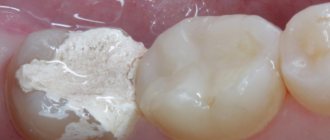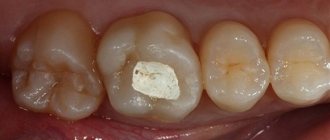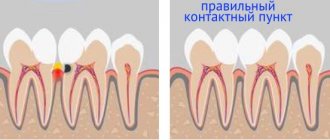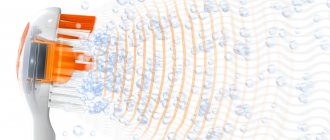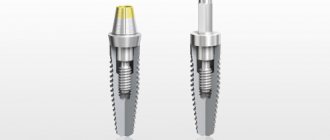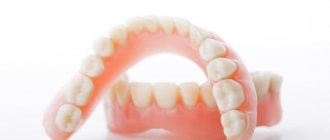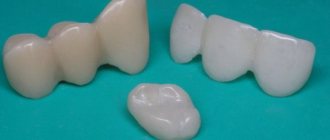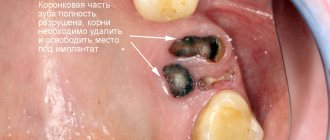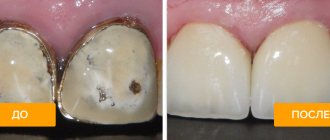Metal fillings
Filling teeth with amalgam
Amalgam is a medical metal containing tin, zinc, mercury and silver. Most often, this filling is placed on the distant chewing teeth. Modern dentists use copper and silver amalgams, where these metals predominate.
The advantages of amalgam-based fillings are as follows:
- Long service life, which can reach 15 years or more;
- Strength;
- Low price;
- Plastic;
- The possibility of preserving tooth color appears if fillings from the latest generations of amalgam are used;
- Easy to install;
- Tight edge seal.
Disadvantages of using amalgam for filling teeth:
- Low aesthetics: the filling will stand out noticeably against the background of the tooth;
- Long curing time;
- The release of mercury vapor, which most likely affects not the patient himself (it has been proven that even when wearing 10 amalgam fillings, the body will not receive mercury exceeding the maximum permissible concentrations), but rather the employees of the dental office;
- It is impossible to install a gold crown, since the amalgam filling will be destroyed;
- Shrinkage of the filling;
- Increased thermal conductivity.
Gold alloy for filling teeth
Fillings made from metals, including their precious analogues, are not popular in modern dentistry, as they are too noticeable on the teeth. While most patients strive for maximum naturalness and naturalness. However, those who decide to install such a filling should know about its advantages and disadvantages.
Advantages of gold alloy fillings:
- Long service life;
- Increased strength.
Disadvantages of gold alloy fillings:
- High price for a filling;
- Impossibility of installation with amalgam fillings.
Non-metallic fillings
Cements for filling teeth
Cements are widely used for the manufacture of a wide variety of fillings. They are included in permanent fillings in adults, these materials are used to fill baby teeth in children, and cements are used to make insulating linings.
- Phosphate cements cannot act as an independent material for making fillings, since they tend to decrease in volume after installation. Therefore, to prevent gaps from appearing between the tooth and the filling, and to avoid a loose fit of the filling, zinc phosphate cements are used only as a spacer when installing other fillings, and they are also used to fix crowns.
- Silicate cement is used to fill a tooth after a layer of phosphate cement has been installed on the pulp. The fact is that silicate material is not able to independently provide the necessary permeability, and it can have a pathogenic effect on the pulp. In addition, this cement will dissolve under the influence of saliva and has toxic properties, which is why modern dental clinics do not use silicate cement.
- Combined silicate-phosphate cement has absorbed all the best qualities of the two previous cements. It does not stick to the walls of the dental cavity, while it is as hard as silicate cement and has the necessary transparency. Another advantage of this cement filling is that it does not conduct heat. The disadvantages of fillings made from silico-phosphate cements are: not very high aesthetic qualities, low strength and poor resistance to the environment in the oral cavity, as well as toxicity to the pulp, and therefore it is necessary to use an insulating lining. It is these fillings that are most often installed in free dental offices, as they are low in cost.
- Glass ionomer cement is another modern cement that is characterized by increased strength and durability. This cement adheres well to the tooth and is not toxic. In addition, in the process of wearing such a filling, fluoride is released from it, which contributes to additional protection of the tooth from carious destruction. However, this modern material also has disadvantages. It is fragile and, like all other cements, has increased abrasion. In this regard, glass ionomer cement is used as insulating linings and for securing dental inlays.
Plastic fillings
In dentistry, plastic is used as a material for making temporary fillings.
Their advantages:
- High hardening speed;
- Resistance to chemical agents;
- No oral irritation.
There are many more disadvantages of plastic fillings than positive qualities:
- Reducing the volume of the filling during operation;
- Subsidence of the filling;
- Quick change of original color;
- Tooth destruction as a result of deformation of the filling.
Plastic fillings include acrylic oxide and carbondent.
Acrylic plastics are produced by a domestic manufacturer and have the following advantages:
- High adhesion (adhesion to tooth tissue);
- Tight fit to the walls of the cavity, negligible shrinkage;
- Easy to dispense powder and liquid;
- Resistance to external irritants;
- Long-term preservation of the original color.
However, despite the strength of acrylic oxide, it is chemically toxic and will eventually lead to the development of an inflammatory reaction under the filling.
Compared to acrylic oxide, carbondent is denser, less toxic, but very fragile and quickly darkens.
Ceramic fillings
Ceramic fillings have a number of advantages, including:
- Increased hardness;
- Resistance to original color;
- Maintaining the original size, no shrinkage;
- Excellent aesthetic qualities.
Ceramic fillings are made as an inlay, that is, according to a pre-made impression of a treated tooth. The configuration of the ceramic filling makes it possible to evenly distribute the load throughout the entire tooth during the process of chewing food. There are several types of ceramic fillings: from pressed ceramics, from metal ceramics, with zirconium oxide included in their composition. One and perhaps the most significant disadvantage of a ceramic inlay is its high cost compared to fillings made of other materials.
Light-curing composite fillings
Light-curing fillings are those that harden as a result of exposure to light of a certain frequency. They are as close as possible to the appearance of a person’s own teeth, almost invisible after their installation, durable and initially look perfect. The advantage of these materials is that they are highly polishable, and their high aesthetic qualities make it possible to use these fillings for the treatment of anterior teeth. However, over time, such fillings need to be replaced, as they will still shrink.
Advantages and disadvantages
The main purpose of such a filling is to treat caries, or rather, to disguise it. Patients who have already tried the new product mention the following advantages:
- There is no need for drilling, the entire process is absolutely painless and discomfort-free.
- The ability to make your smile attractive in just one session.
- It is possible to install fillings even on the front teeth. It does not differ at all from the dentition, since the shade is selected based on the remaining units.
- Suitable for use even in hard to reach places.
- The procedure lasts no more than half an hour.
- The manipulation does not require pain relief, so this technology is suitable even for allergy sufferers who cannot tolerate local anesthesia.
Some patients name the following disadvantages:
- It is very important that dental treatment is carried out by a competent dentist with many years of experience. If during the manipulation the stages of filling are violated, then the result may be negative; pathogenic microorganisms will continue to grow under the artificial material.
- The color of the treated tooth will not change. On the one hand, this is a plus, and on the other, a minus. If you decide to whiten your teeth, the filling will not change shade and will still remain yellowish. Or vice versa - if over time your natural teeth darken, the filling will remain light.
- It is impossible to install a liquid filling if we are talking about advanced caries.
Materials for filling root canals of teeth
Root canals are filled when caries reaches the stage of pulpitis. The essence of filling is to fill the tooth canal as tightly as possible with the selected material. Modern dentistry makes this process painless and quick.
The following materials are used for this:
- Gutta-percha is the result of processing a material such as latex. When heated, gutta-percha becomes viscous, and after cooling it hardens. This material has high biological compatibility with dental tissues, has low toxicity, does not dissolve, and does not cause allergic reactions. If such a need arises, gutta-percha can be removed from the dental canal. The disadvantages of the material include the lack of bactericidal properties, the inability of the material to adhere to dentin, and the difficulty of installation.
- Silver pins are used less and less in modern dentistry, as it has been found that they tend to oxidize and provoke a relapse of inflammation.
- Titanium pins do not provoke allergic reactions, are very durable, light in weight and do not corrode. However, they can only be used if the tooth is slightly damaged and there is no nerve in the canal.
- Natural pastes (sealers) contain various antiseptic and antibacterial components that prevent the development of inflammation, they do not cause difficulties in installation and dissolve over a long time. The disadvantages of sealers include the likelihood of developing an allergic reaction and the presence of toxic components. In addition, upon contact with the mucous membrane, they can cause throbbing pain.
- Polymer pastes (sealers) are used more often than natural ones, since they do not stain the tooth, do not dissolve in liquids, and have good attachment to the canal walls. However, they can provoke an allergic reaction, especially for patients prone to such manifestations.
- Cortismol is a powder that helps eliminate pain after it is introduced into the root canal of a tooth, as it contains hormones. However, it cannot be used to fill the front teeth, as it contains coloring pigments.
- Kanason Combipak acts as an antiseptic and antibacterial agent for filling. It isolates the channel perfectly, but the main disadvantage of using it is the long installation time.
- Glass ionomer cement is not suitable for filling dental canals, as it has low strength and allows fluid to pass through. Therefore, it is often used for filling baby teeth.
- Polymethylsiloxane has an excellent ability to fill even the smallest cavities, as it consists of tiny particles. Its main disadvantage is the novelty of the material and insufficient knowledge of its effect on the body.
- Cements are used to fill tooth canals only after applying isolation.
Modern methods of filling tooth canals
- The depophoresis method allows you to sterilize the canals, filling all existing cracks and cavities. Depophoresis allows you to cure even the most difficult cases, for example, when the tooth canals are crooked or access to them is difficult. Using a special instrument, a medicinal substance (calcium and copper hydroxide) is injected into the canal, achieving complete sterilization.
- Filling teeth using thermophile obturation using heated gutta-percha. This is a simple and reliable way to fill canals, but an unpleasant consequence can be the filling material leaking beyond the boundaries of the canal.
Heated gutta-percha can be used for filling using the following methods:- Injection method, when gutta-percha is applied to the problem area, the temperature of which reaches 100 °C (only a highly qualified dentist can perform the procedure);
The vertical condensation method allows for three-dimensional canal filling, but is very difficult to implement;
- The continuous wave method is similar to the vertical condensation method, but is not as long in time;
- Syringe injection is a quick and convenient method of filling the canal, but it will not be able to reach the lateral tubules.
- Method of filling canals using cold gutta-percha.
- Single pin method (a gutta-percha pin is made according to the shape of the canal);
- The lateral condensation method (several gutta-percha pins are used to fill the canal), in this case there is a risk of fracture of the tooth root and loose filling of its canal;
- The thermomechanical condensation method (the canal is filled using a rotating instrument), in this case there is a risk of instrument fracture and poor-quality filling of the dental canal.
- Mummification of the canal. In this case, the pulp is treated with a large number of antiseptics, which stops the progression of the inflammatory process.
- Retrograde dental filling is a modern method of root canal filling. To perform the procedure, a special nozzle and a gun are used to perform the injection. First, the root is filled with the selected material using a retrograde movement, and then the doctor can move on to vertical filling.
Previously, canal filling was used using a resorcinol-formalin mixture, but this method has many side effects, and modern dentists have abandoned it.
Installation process
Let's look at how dentists install a liquid filling:
- First you need to thoroughly treat the affected unit with a special disinfectant acid. This measure is necessary in order to completely destroy pathogenic microflora from the tooth. Next, you need to wait about 3 minutes for the enamel to dry.
- The tooth is coated with an alcohol-containing substance, this allows the remaining acid to be completely removed.
- Using a special syringe, a liquid filling is “poured” onto the tooth. Its composition penetrates into the deep layers of the tooth, thereby protecting the unit from further proliferation of pathogenic microorganisms. This must be done quickly so that the substance does not begin to harden from exposure to ordinary light.
- The filling is dried under a blue lamp; it is also sensitive to ordinary light. It is for this reason that it is stored exclusively in dark containers.
- At the end of the procedure, the unit is subjected to surface grinding and polishing.
The service life of a kind of dental sealant is from 5 years. If you want to install such a filling, please contact private medical centers.
